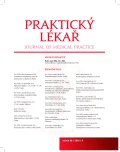Use of telerehabilitation as a complement to regular rehabilitation care
Authors:
D. Hamouzová 1,2; J. Srbová 1; V. Navrátil 1
Authors‘ workplace:
České vysoké učení technické v Praze, Fakulta biomedicínského inženýrství, Kladno, Děkan: prof. MUDr. Ivan Dylevský, DrSc.
1; Oblastní nemocnice Kladno, a. s., Rehabilitační oddělení, Primářka: MUDr. Marta Melicherčíková
2
Published in:
Prakt. Lék. 2018; 98(6): 266-269
Category:
Of different specialties
Overview
Telerehabilitation uses information and communication technology (ICT) to provide rehabilitation to people who are away from healthcare professionals in their homes, on business trips or for other reasons. Telerehabilitation can lead to a significant improvement in client care access. ICT successfully replaces the physician's physical contact with the patient outside the walls of a healthcare facility. The continuity of care for patients with disabilities is increasing. The telepathic concept along with telerehabilitation allows individuals to gain control over the management of their own medical needs. Communicating with a therapist allows personalized care, and personal control through choice. Therapeutic programs have different options. They use remote monitoring systems, robotic and virtual technologies. This work briefly presents the history of telerehabilitation and telephetics, and the most common technology used for remote rehabilitation services. Foreign and domestic studies are also presented on this issue.
KEYWORDS:
telerehabilitation – healthcare – communication technology (ICT)
Sources
1. Kairy D, Tousignant M, Leclerc N, et al. The patient’s perspective of in-home telerehabilitation physiotherapy services following total knee arthroplasty. Int J Environ Res Public Health 2013; 10(9): 3998–4011.
2. Moffet H, Tousignant M, Nadeau S, et al. In-home telerehabilitation compared with face-to-face rehabilitation after total knee arthroplasty: a noninferiority randomized controlled trial. J Bone Joint Surg Am 2015; 97(14): 1129–1149.
3. Parmanto B, Saptono A. Telerehabilitation: state-of-the-art from an informatics perspective. Int J Telerehabil 2009; 1(1): 73–84.
4. Srbová J. Telerehabilitace jako jedna z forem rehabilitační péče u pacientů s totální endoprotézou kolenního kloubů. Bakalářská práce. Kladno: ČVUT FBMI 2017.
5. Středa L, Hána K. eHealth a telemedicína: učebnice pro vysoké školy. Praha: Grada Publishing 2016.
6. Středa L, Panýrek P. eHealth a telemedicina. Praha: High Tech Park 2011. I
7. Svobodová L. Telemedicínské služby [online]. 2013. Dostupné z: http://www.niz.sk/telemedicinske-sluzby/ [cit. 2018-09-29].
8. Russell TG, Buttrum P, Wootton R, Jull GA. Low-bandwidth telerehabilitation for patients who have undergone total knee replacement: preliminary results. J Telemed Telecare 2003; 9(Suppl 2): S44–47.
9. Russell TG, Buttrum P, Wootton R, Jull GA. Internet-based outpatient telerehabilitation for patients following total knee arthroplasty: a randomized controlled trial. J Bone Joint Surg Am 2011; 93(2): 113–120.
10. Australian Physiotherapy Association. Telerehabilitation and Physiotherapy [online]. Dostupné z: http://www.physiotherapy.asn.au/DocumentsFolder/Advocacy_Position_Telerehabilitation_2009.pdf [cit. 2018-09-29].
11. Kellner Z. Při rehabilitaci v Kladrubech pomůže už brzy virtuální terapeut [online]. Dostupné z: https://benesovsky.denik.cz/zpravy_region/pri-rehabilitaci-v-kladrubech-pomuze-uz-brzy-virtualni-terapeut-20171106.html [cit. 2018-09-29].
Labels
General practitioner for children and adolescents General practitioner for adultsArticle was published in
General Practitioner

2018 Issue 6
- Advances in the Treatment of Myasthenia Gravis on the Horizon
- Memantine Eases Daily Life for Patients and Caregivers
- Hope Awakens with Early Diagnosis of Parkinson's Disease Based on Skin Odor
- Memantine in Dementia Therapy – Current Findings and Possible Future Applications
- Metamizole vs. Tramadol in Postoperative Analgesia
Most read in this issue
- Dark lesions in the oral cavity – differential diagnosis
- Surrogacy in the Czech Republic: current status and the responsibility of the general practicioner
- Use of telerehabilitation as a complement to regular rehabilitation care
- Analysis of the most common food-and water-borne diseases in the Czech Republic, 2007–2017
